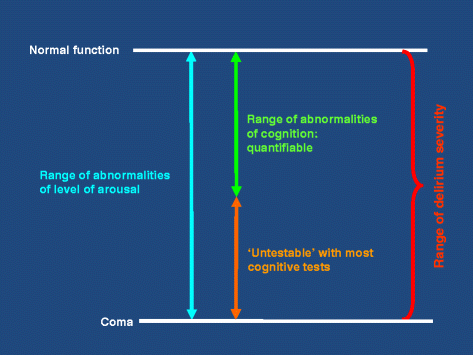The DSM-5 criteria, level of arousal and delirium diagnosis: inclusiveness is safer
- PMID: 25300023
- PMCID: PMC4177077
- DOI: 10.1186/s12916-014-0141-2
The DSM-5 criteria, level of arousal and delirium diagnosis: inclusiveness is safer
Abstract
Background: Delirium is a common and serious problem among acutely unwell persons. Although linked to higher rates of mortality, institutionalisation and dementia, it remains underdiagnosed. Careful consideration of its phenomenology is warranted to improve detection and therefore mitigate some of its clinical impact. The publication of the fifth edition of the Diagnostic and Statistical Manual of the American Psychiatric Association (DSM-5) provides an opportunity to examine the constructs underlying delirium as a clinical entity.
Discussion: Altered consciousness has been regarded as a core feature of delirium; the fact that consciousness itself should be physiologically disrupted due to acute illness attests to its clinical urgency. DSM-5 now operationalises 'consciousness' as 'changes in attention'. It should be recognised that attention relates to content of consciousness, but arousal corresponds to level of consciousness. Reduced arousal is also associated with adverse outcomes. Attention and arousal are hierarchically related; level of arousal must be sufficient before attention can be reasonably tested.
Summary: Our conceptualisation of delirium must extend beyond what can be assessed through cognitive testing (attention) and accept that altered arousal is fundamental. Understanding the DSM-5 criteria explicitly in this way offers the most inclusive and clinically safe interpretation.
Figures
References
-
- Davis DH, Muniz Terrera G, Keage H, Rahkonen T, Oinas M, Matthews FE, Cunningham C, Polvikoski T, Sulkava R, Maclullich AM, Brayne C. Delirium is a strong risk factor for dementia in the oldest-old: a population-based cohort study. Brain. 2012;135:2809–2816. doi: 10.1093/brain/aws190. - DOI - PMC - PubMed
Publication types
MeSH terms
Grants and funding
LinkOut - more resources
Full Text Sources
Other Literature Sources
Medical


